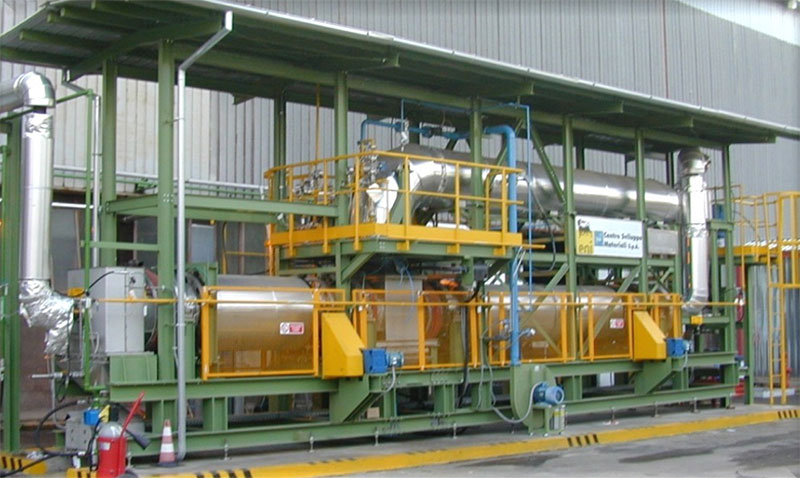Report of the tests carried in November 2011 on the pilot gasifier at the CSM of Rome - IT in order to determine the self-sustenance of the drying process / pyrolysis and gasification of sludge.
The wastewater sludge, residential or industrial whatever their origin, are generally considered as waste and are disposed of in landfill. The increased quantities produced as a result of the increasing number of sewage treatment plants, civil and / or industrial, and the more restrictive regulations regarding the disposal, force to consider with greater care alternative methods to the mere landfill.
Moreover, these materials, once dried to reduce their volumes and costs of transport, acquire a calorific value such as to make them incompatible with the eligibility criteria in landfills. For example, in Italy the PCI limit> 13 MJ / kilograms was introduced by Legislative Decree 36/2003. The sludge, from waste to landfill, become something which must be take advantage of residual heat, keeping them for an extra step in the production cycle and ensuring respect for the environment. Finally, volumes, after the energy yield, are reduced by more than 80%.
During this experimentation conducted on the pilot in 2011, it has been verified the efficiency of the gasifier quantifying the expected tendency to self-sustenance (reached after 8 hours of charging system operation) and checking that the composition of the syngas produced by the two areas (drying / pyrolysis and gasification) proves suitable to characterize the process’ energy carrier.
The tests were carried out with an hourly flow rate of 50 kilograms / h, providing 8 hours of operation at processing temperature (350 ° C for drying, 800 ° C for gasification and 850 ° C for the post-combustion). The 4 hours initially budgeted NOT allowed to reach the conditions for self-sustenance given that, one of the process parameters obtainable with prolonged tests is that related to thermal dispersions, dispersions that are normally specific to a plant that goes to the thermal regime conditions. Such dispersions towards the environment tend to decrease until at a constant value, with increasing time of operation.
So, to make sure to have an operation as long as possible, the sludge gasification tests were organized in 3 shifts.
After the first heating phase, the system has been loaded to the maximum: 390 kilograms. In conjunction with the first part of the process, some oscillations in the measurement of the air flow have been noted, probably due to a compressed air absorption by the CSM network. This phase of oscillation has been stabilized autonomously after about one hour of operation, during which it has been noted the lowering of the flow rate of methane due to the production and combustion of the syngas from the pyrolysis process in the first part of the gasification reactor.
In the side picture the partial replacement of natural gas with the syngas produced keeping constant the temperature at the after-burner is visible.
Added the second material cask, the tendency to self-sustenance has become evident so much so that the temperature of the combustor tended to rise even with very low values of methane flow rates to the burner (9 Nm3 / h). Loading lasted a total of about 7 hours 30 minutes (from 12:30PM to 19:00PM); the total loaded material was found to be 387 kilograms.
In such operating conditions, to maintain the temperatures of the post-combustor in the programmed limits, have been required cooling air’s flow greater than the maximum allowable flow rate (450 Nm3 / h). Therefore, it was decided to turn off the burner and run the process control manually.
After 11PM, in close proximity of the need to begin the shutdown’s proces and in the need to follow such process according to the scheduled procedure, the burner was switched on again bringing it to the minimum possible flow rate (about 6 Nm3 / h).
In this conditions, the temperature at the post-combustor is returned to rise for about 2 hours, up to reach such a temperature (> 950 ° C) as to make decide for the reactor shutdown (01:15AM).
The total duration of the TAS + BIO mixture loading, was then about 6 hours and 10 minutes (from 19:05PM to 01:15AM); the total loaded material was found to be 376 kilograms.
These gasification tests described above have allowed, among other things, to verify the adequacy of the syngas generated to self-support the process of the entire sludge treatment (drying / pyrolysis / gasification), within the limits defined by the experimentation carried out. The syngas for the adopted measures showed a significantly lower content of powders to that recorded for similar technologies (normally equal to 50 mg / Nm3), having found in the cyclonic dust collection system less than 1000 mg for the duration of long-term experimentation (0.1 mg / Nm3).











